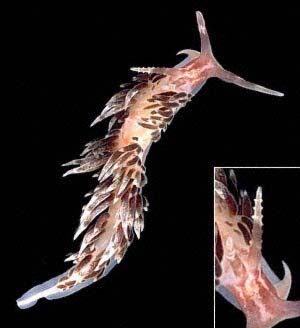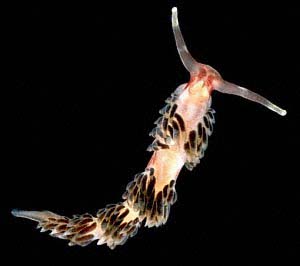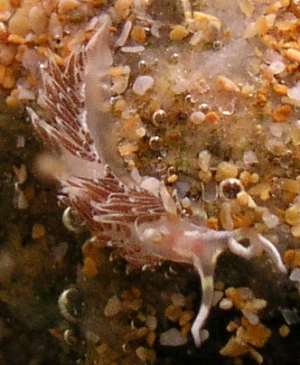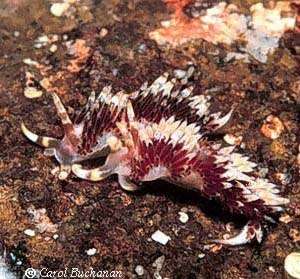

Phidiana newcombi
(Angas, 1864)
Order: NUDIBRANCHIA
Suborder: AEOLIDINA
Family: Glaucidae
DISTRIBUTION
Known throughout New South Wales, Australia, [with records from Eden, in the south, to Angourie in the north] and Victoria.
PHOTO
UPPER: Two-Fold Bay, New South Wales, 17mm long alive, March 1986
LOWER: Callala Point, Jervis Bay, New South Wales, 20mm long alive, November 1984. PHOTOS: Bill Rudman.
The colour pattern is somewhat variable but the head is usually reddish-brown with a white or translucent straw coloured streak up the midline between the rhinophores, and a streak on each side, which runs below the rhinophores and beneath the first ceratal cluster on each side. There is also a diamond-shaped patch, often outlined in white over the heart. A broken white line, runs back from the heart along the dorsal midline. The distal third of the oral tentacles have a yellow or whitish pigmentation while the rest is either red-brown or translucent in colour. There is often a whitish band, sometimes incomplete, halfway up the oral tentacles. The rhinophores can have 4 or 5 ridges or lamellae (see inset on upper photo), but in may specimens these are absent, apparently after regrowth of damaged rhinophores. Another character is that complete specimens uusually have a long tapering "tail" but this is often absent.
Interestingly, a high proportion of animals of this species have damaged "extremities" - rhinophores, oral tentacles and posterior end of foot. Perhaps living in the intertidal makes them more vulnerable to attack from predators, but if this was the single reason I would expect other intertidal species to show a similar level of damage.
Reference:
• Angas, G.F. (1864). Description d'espèces nouvelles appartenant à plusieurs genres de Mollusques Nudibranches des environs de Port-Jackson (Nouvelles-Galles du Sud), accompagnée de dessins faits d'après nature. Journal de Conchyliologie, 12: 43-70
Rudman, W.B., 1999 (March 9) Phidiana newcombi (Angas, 1864). [In] Sea Slug Forum. Australian Museum, Sydney. Available from http://www.seaslugforum.net/find/phidnewc
Related messages
Phidiana newcombi? from South Australia
February 1, 2005
From: Dennis Hutson

Does anybody know what type of sea slug this is? I found it under the Edithburgh jetty.
Locality: Edithburgh Jetty, South Australia.Depth: 6 metres. Length: 5 mm. 23 Jan. 2005. Pylons and rocky bottom. Photographer: Dennis Hutson
Cheers
Dennis.
dghutson@ozemail.com.au
Hutson, D.G., 2005 (Feb 1) Phidiana newcombi? from South Australia. [Message in] Sea Slug Forum. Australian Museum, Sydney. Available from http://www.seaslugforum.net/find/13058Dear Dennis,
I think this is Phidiana newcombi but it is a bit hard to be sure because I can't see the rhinophores, and I need them to see some vital characters. The colour is not a perfect match but it's the best I can do
Best wishes,
Bill Rudman
Phidiana? from Port Stephens
March 9, 1999
From: Carol Buchanan

Hi Bill
Here is another nudi from Port Stephens I would like you to check. It is about 18mm long.
thanks
Carol
nandcimages@key.net.au
Buchanan, C., 1999 (Mar 9) Phidiana? from Port Stephens. [Message in] Sea Slug Forum. Australian Museum, Sydney. Available from http://www.seaslugforum.net/find/649Dear Carol,
I'm pretty sure its Phidiana newcombi. I can't be sure from the picture that your animals have the characteristic ridges or lamellae on the rhinophores, but as I say above, the rhinophores are often damaged in this species, and the replacement structures do not have the ridges.
Best wishes,
Bill Rudman.
